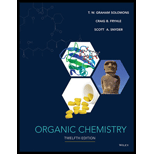
Concept explainers
Interpretation:
The chirality of the given objects is to be discussed.
Concept introduction:
The objects that are nonsuperimposable or not identical with their mirror images are known as chiral objects.
The objects that are superimposable with their mirror images are achiral objects. These objects have a centre of symmetry or plane of symmetry.
Answer to Problem 1PP
Solution:
a) Achiral
b) Achiral
c) Chiral
d) Chiral
e) Chiral
f) Achiral
g) Chiral
h) Achiral
Explanation of Solution
a) A screwdriver
A screwdriver is an achiral object as it forms superimposable mirror images. A screwdriver has a plane of symmetry passing through its longitudinal axis. This makes it a symmetric object, superimposable with its mirror images, which makes it achiral.
So, a screwdriver is an achiral object.
b) A baseball bat
A baseball bat is an achiral object as it has a plane of symmetry, which makes it a symmetric object, superimposable with its mirror images. It forms superimposable mirror image due to which it is said to be an achiral object.
So, a baseball bat is an achiral object.
c) A golf club
A golf club is a chiral object because the mirror images of a golf club are non-superimposable due to which it is asymmetric and hence, shows chirality.
So, a golf club is a chiral object.
d) A tennis shoe
A tennis shoe is a chiral object as it shows asymmetric behaviour. The mirror images of a tennis shoe are non-superimposable on the original image due to its curvature toward the tip of the shoe, which makes it asymmetrical and hence, shows chirality.
So, a tennis shoe is a chiral object.
e) An ear
An ear is a chiral object because the mirror images of an ear are nonsuperimposable on the original image and are not identical with its mirror image, due to which it is asymmetric and hence, shows chirality.
So, an ear is a chiral object.
f) A woodscrew
A woodscrew is an achiral object as it shows symmetry. The mirror image of a woodscrew is superimposable on the original image along an axis of symmetry, due to which it is a symmetric molecule and hence shows an achirality.
So, a woodscrew is an achiral object.
g) A car
A car consists of many objects, such as two front seats, a dashboard, and a steering wheel. A car is a chiral object because the mirror images of these interiors are nonsuperimposable on the original image and not identical with their mirror image, due to which a car is asymmetric and hence shows chirality.
So, a car is a chiral object
IF considering only the outer morphology of the car, it is symmetric along an axis, superimposing its mirror image and making it an achiral molecule.
h) A hammer
Superimposable mirror images are formed by a hammer. A hammer has a plane of symmetry, which makes it a symmetric object. Also, it is superimposable with its mirror images, which makes it achiral.
So, a hammer is an achiral object.
Want to see more full solutions like this?
Chapter 5 Solutions
ORGANIC CHEM. VOL.1+2-W/WILEYPLUS
- Assign the functional group bands on the IR spectra.arrow_forwardFind the pH of a 0.120 M solution of HNO2. Find the pH ignoring activity effects (i.e., the normal way). Find the pH in a solution of 0.050 M NaCl, including activityarrow_forwardPlease help me answer these three questions. Required info should be in data table.arrow_forward
- Draw the major organic substitution product or products for (2R,3S)-2-bromo-3-methylpentane reacting with the given nucleophile. Clearly drawn the stereochemistry, including a wedged bond, a dashed bond and two in-plane bonds at each stereogenic center. Omit any byproducts. Bri CH3CH2O- (conc.) Draw the major organic product or products.arrow_forwardTartaric acid (C4H6O6) is a diprotic weak acid. A sample of 875 mg tartaric acid are dissolved in 100 mL water and titrated with 0.994 M NaOH. How many mL of NaOH are needed to reach the first equivalence point? How many mL of NaOH are needed to reach the second equivalence point?arrow_forwardIncluding activity, calculate the solubility of Pb(IO3)2 in a matrix of 0.020 M Mg(NO3)2.arrow_forward
- Order the following series of compounds from highest to lowest reactivity to electrophilic aromatic substitution, explaining your answer: 2-nitrophenol, p-Toluidine, N-(4-methylphenyl)acetamide, 4-methylbenzonitrile, 4-(trifluoromethyl)benzonitrile.arrow_forwardOrdene la siguiente serie de compuestos de mayor a menor reactividad a la sustitución aromática electrofílica, explicando su respuesta: ácido bencenosulfónico, fluorobenceno, etilbenceno, clorobenceno, terc-butilbenceno, acetofenona.arrow_forwardCan I please get all final concentrations please!arrow_forward
 Organic Chemistry: A Guided InquiryChemistryISBN:9780618974122Author:Andrei StraumanisPublisher:Cengage Learning
Organic Chemistry: A Guided InquiryChemistryISBN:9780618974122Author:Andrei StraumanisPublisher:Cengage Learning
